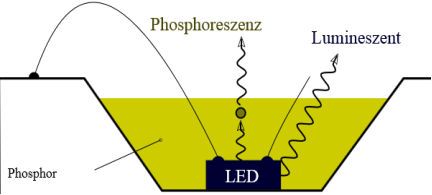Researchers of the University of California Santa Barbara announced a breakthrough research that can improve LED phosphor to more brightness and efficiency. The researchers said that their goal is to reach 90% optical efficiency, or 300 lumens per Watt.
Phosphors are applied to LED chips in the way that photons are firstly emitted from a GaN blue LED through the phosphor and then converted into a mixed color range yellow/orange. When it is combined with the blue light, green, yellow and orange light will emit white color.
The production of efficient phosphor material production is a highly complicated process which requires highly sophisticated production methods. The crystal structure of the phosphor material plays a key role when it comes to convert blue LED light into white coloir. Until now there is still no exact explanation what makes some phosphors valid and some invalid as some photons are always wasted by heat generation.
As phosphor material tends to lose it luminous efficiency att high temperatures, UCSB researchers have stressed the importance of choosing the right crystal, making fluorescent materials work more effectively with the same luminous efficiency at elevated temperatures.
The researchers of UCSB have conducted various calculations based on the density functional theory and have determined the crystal structure rigidity as a key factor affecting the efficiency of the phosphor. In addition, the indicators of structural rigidity can be calculated by means of the density functional theory, which means the phosphor can be filtered before use. This breakthrough discovery provides a fast track for high efficiency and high brightness LED lighting.
It is the UCBS researchers’ declared goal is enhance LED luminous efficiency to 90%, or 300 Lumen per Watt. Latest developments are promising. The current laboratory data shows efficiency rates of 60% which is already a high luminous efficiency compared to incandescent light efficiency of about 5% and fluorescent lighting with a rate jut slightly higher than 20%. sm.


